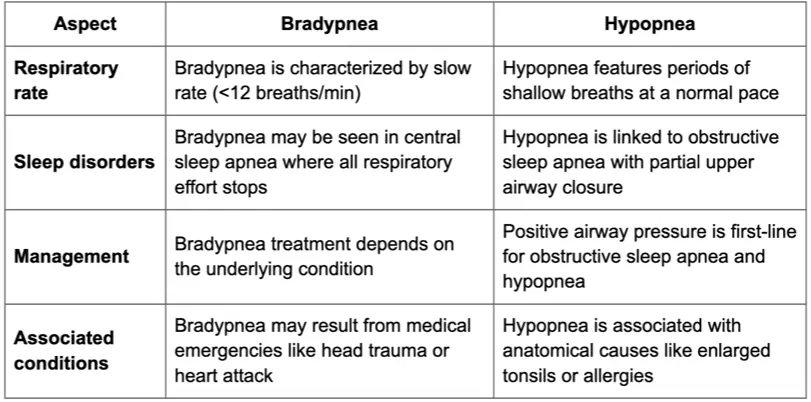The Differences, Causes, and Implications for Sleep and Respiratory Health
Breathing is an automatic process that most people do not consciously think about. However, abnormal respiratory patterns can be an important indicator of underlying health conditions.
Understanding key differences between respiratory abnormalities like hypopnea and bradypnea is crucial not only for accurate diagnoses but also for identifying effective treatments like NightLase® therapy offered by Allure Medical.
Breathing Basics
Normal breathing for an adult at rest involves 12-20 breaths per minute. This respiratory rate, along with depth of breathing, helps determine if respiration is normal or abnormal. Slower or faster rates, as well as shallow or deep breathing, signify potential problems.
The depth and rate of breathing work together to provide oxygen throughout the body and remove carbon dioxide waste. Every inhalation brings oxygen into the lungs to be distributed via the bloodstream. Exhalation eliminates carbon dioxide generated by cell metabolism.
When breathing basics are disrupted, vital oxygen and carbon dioxide levels are impacted. Understanding the characteristics and causes of different respiratory changes empowers both patients and professionals.
What is Bradypnea?
Bradypnea refers to abnormally slow, deep breathing. Adults with bradypnea breathe fewer than 12 times per minute when at rest.
Several serious medical conditions can manifest as bradypnea:
- Increased intracranial pressure: Pressure on the brain from head trauma, tumors, or other causes can suppress the respiratory center. This results in slower, deeper breaths.
- Metabolic acidosis: Buildup of acids in the blood depresses the medullary respiratory centers, lowering the breathing rate. Causes include diabetes, kidney failure, and lactic acidosis.
- Carbon monoxide poisoning: Binding of carbon monoxide to hemoglobin reduces oxygen carrying capacity. The body attempts compensation via slower, deeper breathing.
- Congestive heart failure and heart disease: Fluid in the lungs from heart conditions triggers wide, slow breathing in an effort to obtain sufficient oxygen.
Bradypnea symptoms primarily include shortness of breath and general breathing problems. Oxygen levels may decrease from reduced respiratory rate, while carbon dioxide accumulates. If bradypnea is left untreated, respiratory failure can occur from inadequate gas exchange.
What is Hypopnea?
Hypopnea, on the other hand, involves periods of overly shallow breathing during sleep. It is defined as at least 30% reduced airflow for 10 seconds or longer, associated with oxygen desaturation.
Hypopnea frequently accompanies obstructive sleep apnea (OSA). In OSA, the airway collapses during sleep, blocking airflow completely (apnea). When patency partially recovers, hypopneic episodes follow, with decreased but not absent breathing.
Respiratory effort continues during hypopnea despite reduced air movement. The intercostal muscles between the ribs and diaphragm contract actively. This distinguishes hypopnea from central sleep disorders where respiratory effort ceases.
Symptoms of hypopnea include loud snoring, breathing pauses, and arousals associated with deeper breaths trying to restore normal oxygen. Over time, hypopnea can cause chronic sleep deprivation and changes in blood oxygen/carbon dioxide levels.
The NightLase® Solution for Sleep Problems
While hypopnea and bradypnea pose significant challenges in both diagnosis and treatment, a revolutionary solution has emerged to address these issues.
NightLase® therapy from Allure Medical offers a non-invasive, patient-friendly treatment designed to improve the quality of a patient’s sleep.
This unique therapy utilizes laser-induced tightening effects to reduce sleep apnea and decrease snoring amplitude, all by contracting collagen in the oral mucosa tissue.
Why Choose NightLase®?
Non-invasive: Unlike other treatments, NightLase requires no anesthesia and involves no chemical treatment.
Effective: Research shows a high success rate in positively altering sleep patterns.
Convenient: A full course consists of three to five 15-minute sessions over two to three months.
NightLase is a game-changer for patients who prefer a non-intrusive solution. It requires no device to be worn during sleep, making it a highly comfortable and satisfying option. Results have been shown to last up to a year and can be repeated as needed.
Comparing Bradypnea and Hypopnea
While both abnormal, bradypnea and hypopnea have distinct differences:

Other Abnormal Respiration Patterns
Beyond hypopnea and bradypnea, other disordered breathing patterns include:
- Tachypnea: Tachypnea refers to abnormally rapid breathing at a rate faster than 20 breaths per minute. It is characterized by fast, shallow respirations. Tachypnea can occur in conditions like pneumonia, COPD exacerbations, and other disorders that increase metabolic demands and respiratory drive.
- Hyperpnea: Hyperpnea is a pattern of deep, rapid breathing at a fast pace. It indicates an increased respiratory drive stemming from causes like anxiety, fever, sepsis, metabolic acidosis, and other states of physiologic stress. The deep, fast breathing of hyperpnea aims to blow off excess CO2 and meet metabolic needs.
- Apneustic breathing: Apneustic breathing features prolonged, deep inspirations followed by incomplete exhalations. Individuals have difficulty fully exhaling and pause with lungs inflated. This abnormal pattern results from damage to the brainstem respiratory centers. The inhalations are excessively deep and last several seconds.
- Cheyne-Stokes: Cheyne-Stokes respiration involves cycling between a period of apnea (no breathing) and a period of deep, rapid breathing. There is a distinctive waxing-waning pattern of respiratory depth and rate. Cheyne-Stokes often occurs in patients with heart failure as a result of respiratory center instability.
- Biot’s respiration: Biot’s breathing is characterized by irregular patterns of rapid breathing followed by an apneic period when breathing ceases entirely. There is an arrhythmic alternation between tachypnea and apnea. Biot’s respiration indicates significant damage to the brainstem and can occur with strokes, tumors, trauma.
Each abnormality has unique characteristics and implications for urgent evaluation.
Diagnostic and Treatment Approaches
Detecting irregular respiratory patterns starts with monitoring rate, depth, and rhythm of breathing. Measuring oxygen saturation also helps identify hypoxemia. Blood gas analysis determines carbon dioxide and oxygen levels.
Early medical attention for breathing abnormalities can be lifesaving. Respiratory therapists play key roles in treatment and ongoing management of disordered breathing. Pulmonary and critical care medicine specialists are also invaluable for diagnosis and therapy.
Depending on the underlying condition, treatment may involve:
- Supplemental oxygen
- Medications to address heart failure, acidosis, etc.
- Mechanical ventilation
- BiPAP or CPAP for sleep apnea
- Breathing exercises like diaphragmatic breathing, pursed lip breathing
For bradypnea and hypopnea specifically, identifying and addressing the root causes is critical alongside supporting respiration.
Special Considerations
Certain populations require unique considerations related to respiratory patterns:
1. Pediatric Patients
Infants normally have faster respiratory rates than older children and adults, ranging from 30-60 breaths per minute in newborns to 24-60 breaths per minute by 1 year of age. Respiratory rate norms need to account for developmental stages when assessing pediatric patients. Abnormal rates may signify illness or distress.
2. Brain Injury Patients
Injury to the brainstem and medulla oblongata where respiratory control centers are located can impair breathing regulation. This can lead to slow, shallow breathing known as bradypnea. Careful monitoring of respiratory rate and depth is important in these patients.
3. Anxiety Disorders
Hyperventilation, or breathing excessively fast and deep, is common in anxiety disorders and panic attacks. Despite increased minute ventilation, these patients often feel short of breath. This is likely due to altered carbon dioxide levels from hyperventilation. Teaching breathing control techniques can help patients manage anxiety-related hyperventilation and perceived dyspnea.
Prevention and Awareness
Being attuned to your own breathing can promote early symptom recognition and prompt evaluation:
- Perform regular self-checks of respiration rate and depth.
- Notice if breathing becomes shallow or you feel short of breath.
- Track if you are frequently awakened gasping for air or snoring.
Routine well visits allow healthcare providers to monitor respiratory status and check oxygenation. Understanding the role of chemoreceptors in modulating breathing also assists detection of abnormalities before complications arise.
Conclusion
Bradypnea and hypopnea have distinct characteristics but both indicate threats to respiratory health that require medical attention. Recognizing irregular breathing patterns, evaluating possible causes, and pursuing evidence-based treatment can improve outcomes in these disorders.
Consult your physician promptly about sustaining changes in respiration. With expertise from specialists at Allure Medical, patients can find solutions for even complex breathing and sleeping challenges. Schedule an online appointment today to get started.






